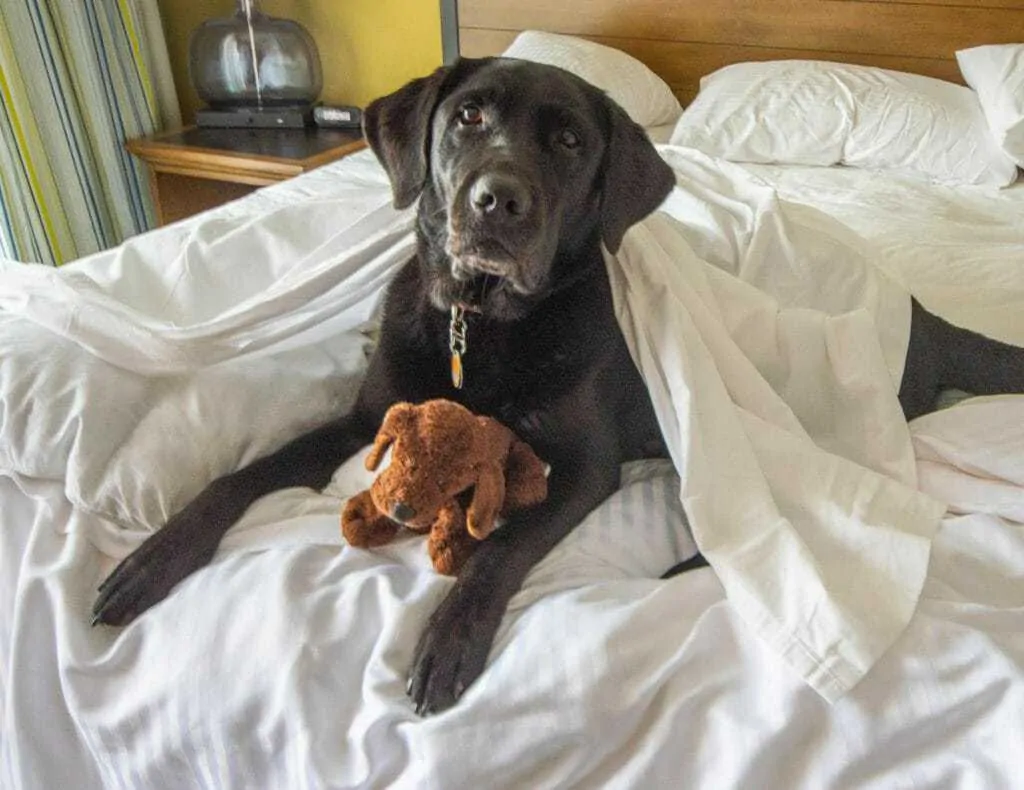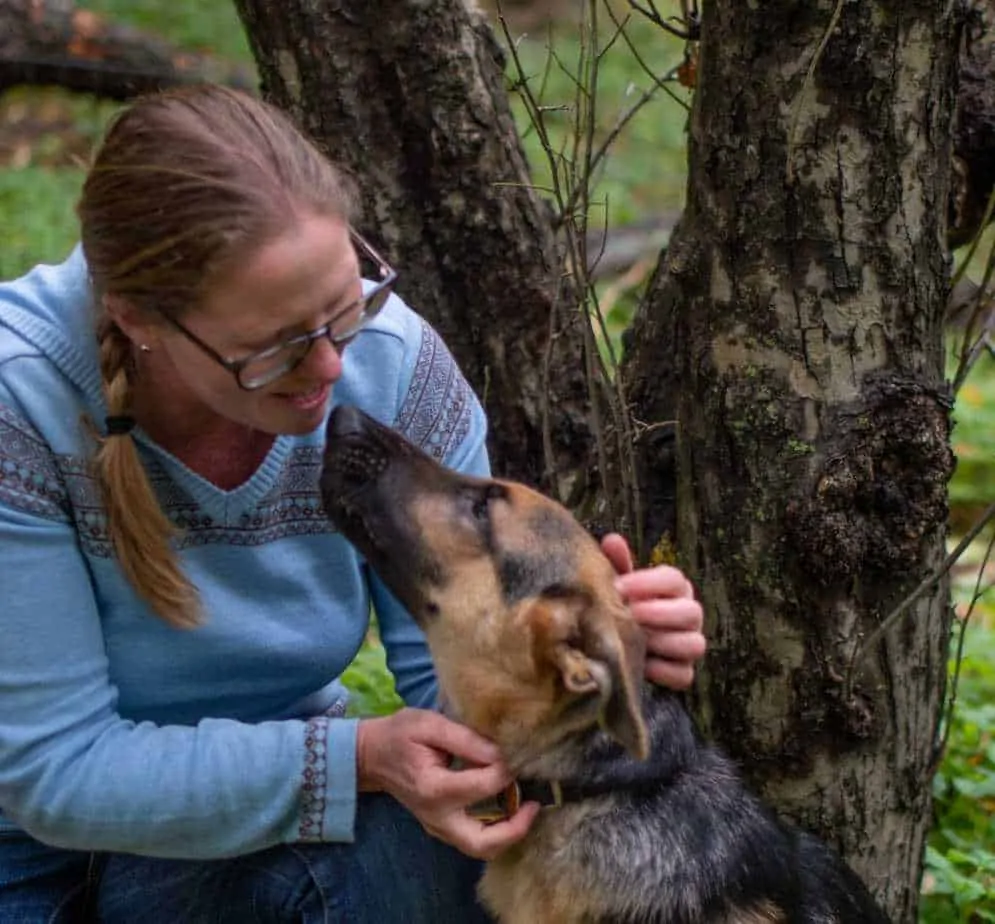Dogs make fabulous adventure partners — they are resilient, rugged, and up for anything. But that doesn’t mean that accidents, mishaps, and illnesses won’t occur. If you share your home with a dog, you can prepare for minor and major emergencies with a bit of knowledge and a well-stocked dog first aid kit. Here are 18 dog first aid kit essential items, as well as some preparation tips for dealing with medical mishaps.
Can you tell when your dog isn’t feeling well? Photo credit: Tara Shatz
Contents
Basic Dog First Aid Kit Essentials
Many items in your human first aid kit can also be used in your dog first aid kit. The following basic items can be purchased at your local pharmacy or online. You can also find complete pet first aid kits on Amazon — just be sure to add the following dog first aid kit essentials if they aren’t included in your dog first aid kit:
- Gauze pads – For protecting broken toenails, wounds, and hot spots.
- Alcohol prep pads – For cleaning and sterilizing wounds
- Antibiotic ointment – To treat minor cuts and scrapes.
- Emergency blanket – To keep your dog warm if they become injured or ill. An emergency blanket is especially useful when you are traveling our camping.
- Gauze rolls – Use for wrapping wounds or as an emergency muzzle.
- Hydrogen peroxide – To induce vomiting, but only when directed by a veterinarian.
- Instant ice pack – To reduce swelling and inflammation.
- Disposable gloves – Reduce the risk of contamination during medical exams.
- Petroleum jelly – To lubricate the rectal thermometer.
- Rectal thermometer – Your dog’s normal body temperature is between 101°F and 103°F.
- Medical scissors with blunt tips – For various tasks, including cutting your dog’s fur for easier wound examination and cutting gauze to create custom bandages.
- Sterile saline solution – Used for flushing your dog’s eyes.
- Tweezers – For removing splinters and ticks.
- Benadryl – Good for bites, stings, and allergic reactions. Here is the standard dosage information for giving Benadryl to dogs.
Additional Requirements for Dog First Aid Kits
Caption: Preparing for minor injuries will prevent them from become major medical emergencies. Photo credit: Tara Schatz
In addition to the items listed above, you will need a few specialty items to prepare for common medical mishaps, including:
- A pet first aid book – Find quick answers and techniques to common medical issues that your dog may experience.
- Vetrap – This is a self-adhesive bandage roll that won’t stick you your dog’s fur or skin. It stays in place and provides firm support, making it a great multi-purpose bandage for many types of injuries and wounds.
- A soft muzzle – Even kind, gentle dogs will sometimes bite if they have been injured and are in distress. A secure muzzle is an important first aid kit essential to keep you and other helpers safe. Don’t let an emergency situation be the first time you introduce your dog to a muzzle. Pick low-stress situations to train your dog to accept a muzzle before you need it.
- A prescription pain medication – Ask your veterinarian for a prescription of the correct dosage of Rimadyl for your dog. Rimadyl is an anti-inflammatory for pain management, which can be used for painful emergencies such as broken bones, sprains, or other injuries.
- Dog nail clippers – Useful for cutting broken toenails.
Tips for Dealing with Your Dog’s Medical Mishaps
Caption: Remember to remain calm as you address your dog’s symptoms. Photo credit: Tara Schatz
A first aid kit is only as useful as the person wielding it, and the more prepared you are for a dog emergency, the better you’ll be at dealing with unpredictable situations. Here are a few tips to help you prepare yourself for canine injuries, mishaps, and illness.
- Stay calm. The first thing you should do when handling any type of emergency is take a deep breath. Your dog is counting on you to make important decisions with level-headed clarity. Panicking will absolutely not help the situation.
- Pay attention. Your dog can’t tell you when something is wrong, so it’s important to pay attention and understand his body language so you’re aware when something is wrong.
- Keep your first aid kit with you. If you travel, hike, or camp with your dog, be sure to bring along your first aid kit, and make sure it is fully stocked.
- Program emergency numbers into your phone – Take a moment right now to find the following numbers for your area: your local vet, poison control, and emergency animal hospital. When every minute counts, you will be grateful you have these at the ready.
- Take a pet first aid course that includes CPR – Knowledge is power, my friends, and if you live with dogs, taking a first aid course could be one of the best investments you can make into their health and well-being. Ask your local veterinarian about course offerings near you.
Tips for Keeping Your Dog Safe and Healthy
Caption: Keeping your dog on a leash prevents many problems. Photo credit: Tara Schatz
Yes, injuries and illness happen to everyone, but there are definitely steps you can take to minimize the risks. Having a well-stocked pet first aid kit on hand is very helpful for handling mishaps after they’ve occured, but you know what they say about an ounce of prevention. Follow these tips to ensure your dog remains safe and healthy.
-
- Keep regular appointments with your veterinarian. Don’t wait for something to go wrong to visit the vet. Schedule annual check-ups and keep your dog up-to-date on vaccines.
- Teach your dog basic obedience skills. Training is one of the most essential tools for keeping your dog safe. Training your dog to follow basic commands like come and stay can prevent road accidents and altercations with other animals.
- Put your dog on a leash. There’s a time and place for off-leash dogs, especially if they are well trained. In most situations, keeping your dog on a leash is safer for everyone. A leash will prevent issues such as accidental ingestion of poisons, falls, chasing wildlife, road accidents, dog fights, and injuries resulting from high-speed trauma.
- Keep toxic household products away from your dog. You probably know that chocolate, antifreeze, and medicines are bad for your dog, but did you know that grapes and sugar-free gum are also toxic? Pet Poison Helpline has an overview of common household products that are poisonous for dogs. Keep your dog safe and put these items out-of-reach.
Your dog is part of your family, and the best way to keep your family members safe is to prepare for the what-ifs that come with living with dogs. Learn how to handle emergency situations, keep your dog first-aid kit stocked and ready, and prevent common injuries and illnesses by following the advice outlined above.
Hope this dog first aid kit guide was helpful!

Tara spends much of her time raising puppies for Guiding Eyes for the Blind. She has been volunteering with Guiding Eyes for the past 12 years, and is currently raising her 9th puppy, a frisky German shepherd named Gatsby. Tara will work with Gatsby for a year, providing him with a loving home, obedience training, and many new experiences to help him become a guide dog.
Tara has been a passionate animal lover since she was a little girl. She got her first dog when she was four years old, and has lived with a rotating cast of animals ever since. She is fascinated by the complex bonds that develop between human and animals, and is dedicated to helping people use humane and effective training methods to build deeper relationships with their pets.



